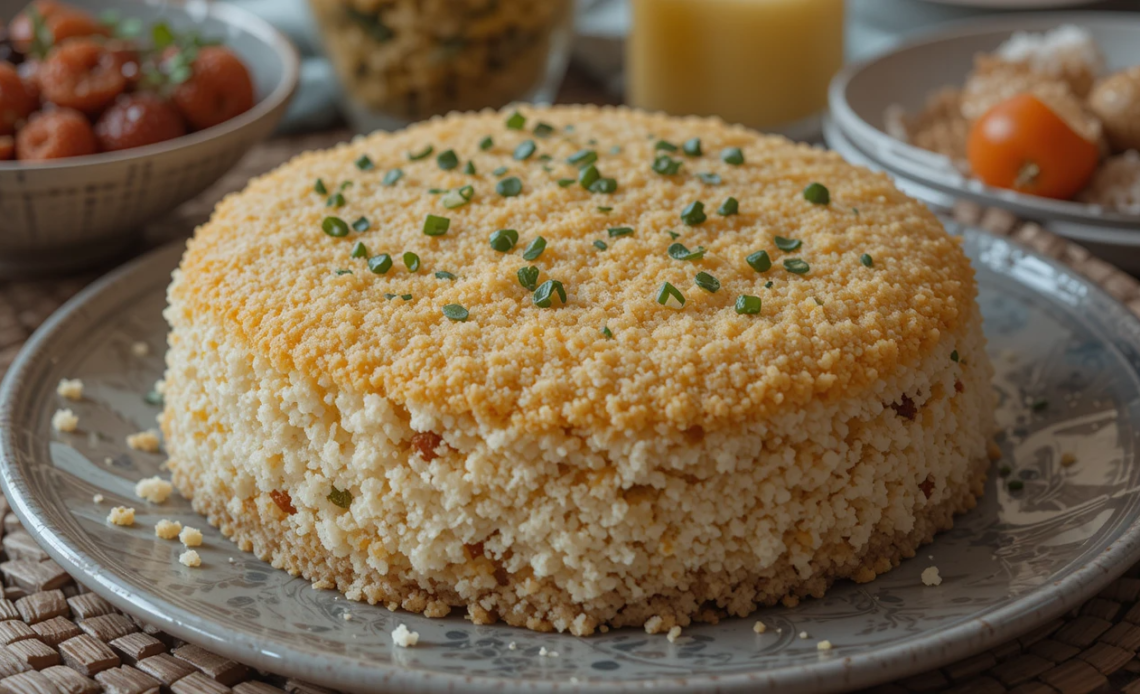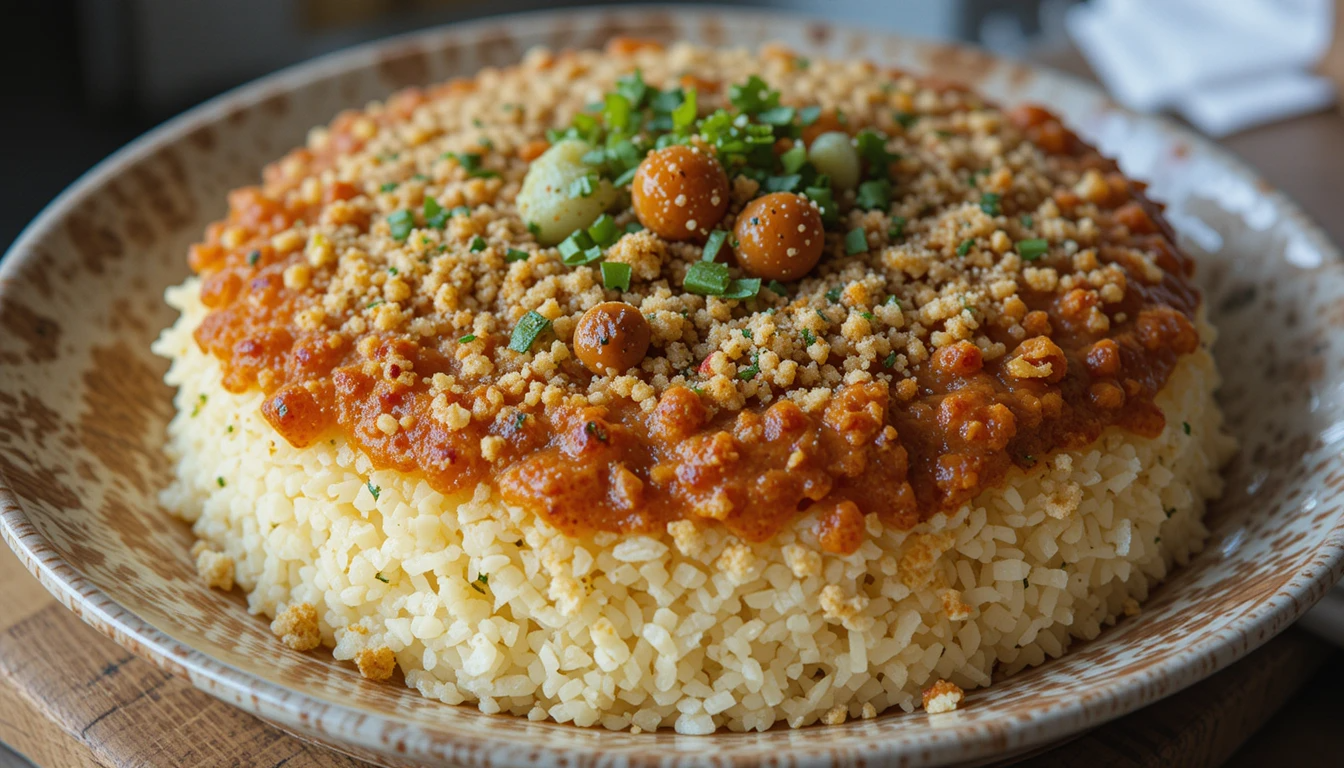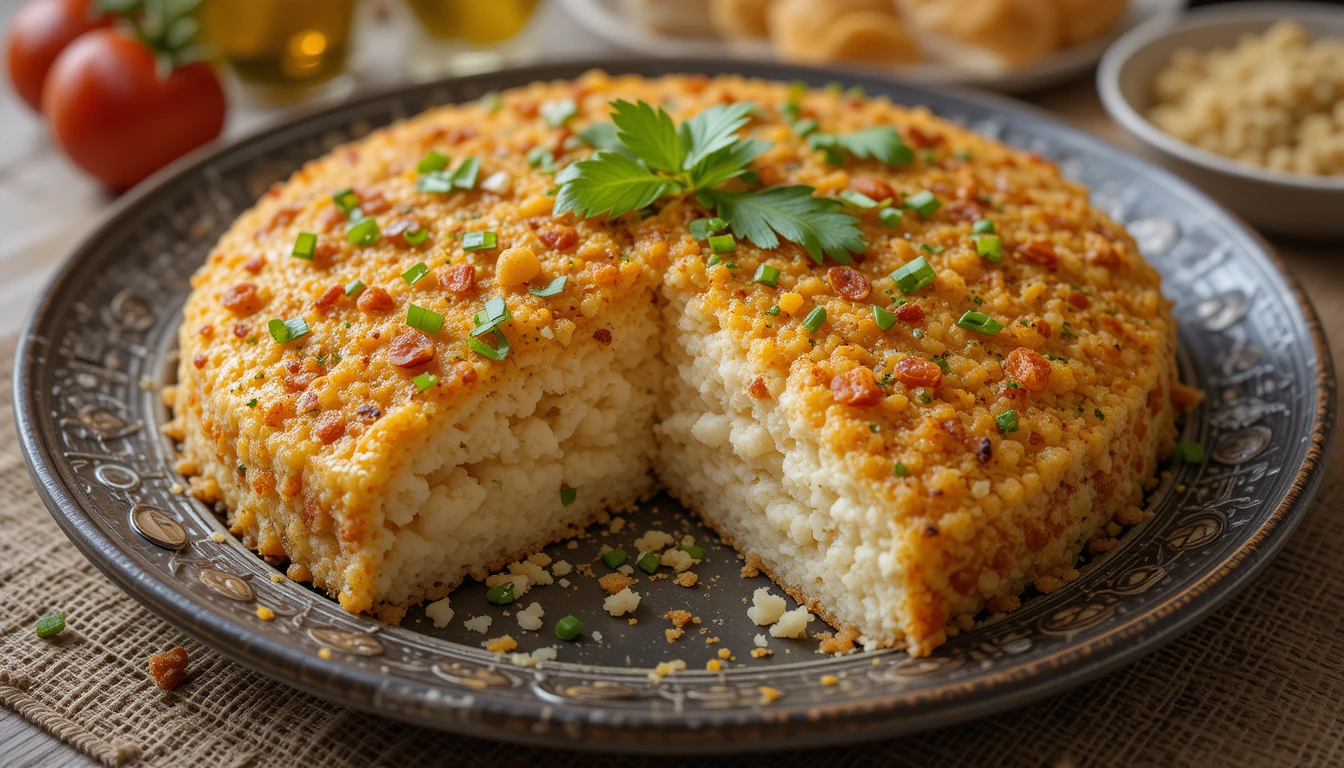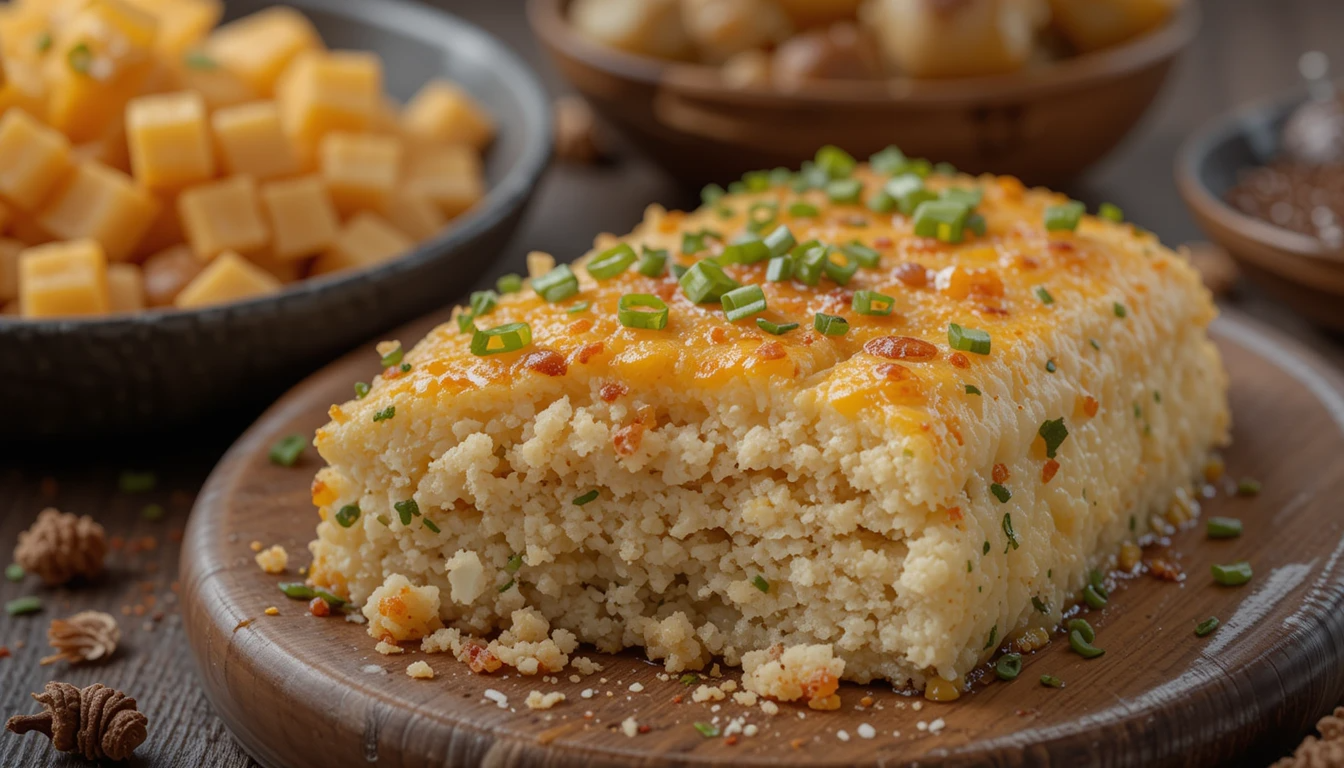
Knafeh is a traditional Middle Eastern dessert known for its delicate, crispy pastry and sweet, creamy filling. It pairs layers of shredded dough or semolina with warm, gooey cheese, all soaked in fragrant syrup. Beloved across the region, it embodies hospitality, celebration, and centuries of shared culinary heritage.
Introduction
Imagine the aroma of butter gently sizzling on a hot pan, melding with the sweetness of rose water and a whisper of orange blossom. Then envision biting into a crispy, golden pastry that reveals a soft, melted center beneath a gloss of sugary syrup. If your taste buds are already doing cartwheels, you’ve landed in the right place! Knafeh is so much more than a dessert; it’s a delightful symbol of unity across the Middle East that carries stories, traditions, and warmth in every mouthful. From family gatherings to bustling street-side bakeries, this treat somehow feels both indulgent and comfortingly familiar at the same time.
But beyond its irresistible taste, Knafeh represents a culinary journey shaped by geography, culture, and time-tested methods. Countless variations exist, each with its own signature style, texture, and twist. Today, you’re going to discover exactly what makes Knafeh a dish worth trying (and talking about!). You’ll also learn how different regions put their special spin on the dessert, the secret ingredients that make it so compelling, and the best ways to serve it to wow your family and friends. By the end of this guide, you’ll feel like an honorary connoisseur of Knafeh, ready to indulge with confidence.
So, loosen your belt a notch, and prepare for a virtual feast of insights. We’ve got the history, science, artistry, and—most importantly—the love that goes into making Knafeh. Get comfy, because this journey is going to be sweet, playful, and packed with everything you need to know.
Disclaimer: This article is for informational purposes only and does not replace professional advice on nutrition, dietary restrictions, or health concerns.
A Brief History of Knafeh

The Early Traces
Knafeh has been around for centuries, treasured by communities across the Middle East. Historically, the origin of Knafeh can be traced to the Levant region—places like Palestine, Lebanon, and Syria are strong contenders for its earliest roots. Over time, it spread across North Africa, the Arabian Gulf, and beyond, blending seamlessly into local cultures.
While exact dates are tricky to nail down, numerous gastronomical historians and food experts point to the medieval era as a key period for the dessert’s initial popularity. In fact, references to a dish resembling Knafeh appear in writings from the Abbasid Caliphate (8th to 13th century). These ancient cookbooks often detailed recipes involving shredded wheat, cheese, and syrupy sweeteners, hinting at the dessert’s longstanding appeal.
Cultural Significance
The significance of Knafeh goes beyond mere flavor. In many Middle Eastern countries, Knafeh is served during festivals, weddings, holidays, and momentous family milestones. It symbolizes togetherness—a shared indulgence that brings people closer. You’ll often find it prepared in large, circular trays, cut into generous squares or triangles, inviting everyone to indulge side by side.
Even the process of making Knafeh carries communal undertones. Grandmothers teach grandchildren how to spin the delicate dough, how to balance sugar and spice, and how to gauge the right temperature. This generational passing down of culinary wisdom cements Knafeh as part of the region’s intangible cultural heritage.
Authoritative Reference: According to a publication by the Smithsonian Institution on Middle Eastern culinary traditions, desserts like Knafeh serve as cultural anchors that maintain and celebrate a shared identity (Smithsonian).
Types of Knafeh
Rough Kataifi vs. Fine Kataifi
When you hear “shredded pastry” or “shredded dough” in the context of Knafeh, you might visualize wispy strands meticulously draped over one another. This is called kataifi. Some Knafeh variations use a coarse version of kataifi, giving the pastry a crunchy bite. Others prefer a finer, hair-like texture for a more delicate feel. Both deliver that signature crispness, but the mouthfeel can vary significantly depending on which style is chosen.
Semolina-Based Knafeh
Another popular approach swaps the shredded dough for a semolina batter. This style, often called Knafeh Nabulsi, hails from the city of Nablus in Palestine. The result? A softer, cakier crust that soaks up the syrup more thoroughly. The semolina variety also tends to hold the melted cheese in a slightly firmer embrace, offering a different form of satisfaction when you take that first bite.
Cheese Fillings & Variations
The type of cheese can greatly influence your Knafeh experience. Traditionally, mild white cheeses like Nabulsi or Akkawi are used because they melt beautifully and have a subtle, clean flavor that complements the sugar syrup. But in modern kitchens, mozzarella, ricotta, or even mascarpone might make cameo appearances, depending on what’s readily available.
For sweet-toothed adventurers, some versions replace or supplement cheese with clotted cream (known as ashta). This cream-based variation offers a velvety filling that harmonizes perfectly with the crisp pastry. Meanwhile, other spins on Knafeh introduce chopped pistachios, walnuts, or almonds for crunch.
The Science Behind the Sweetness

Chemistry of Syrup Soak
One distinctive feature of Knafeh is how it manages to stay crispy despite a generous soaking in sugar syrup. The secret lies in a balance between cooking temperature, dough texture, and the consistency of the sugar syrup. When the kataifi or semolina is cooked at a high enough temperature, it develops a robust, toasted structure that can handle moisture without turning soggy right away.
Moreover, the syrup is often boiled to a certain concentration that ensures it’s viscous enough to coat the pastry but not so runny that it seeps in and ruins the crunch factor. A typical Middle Eastern simple syrup might include sugar, water, lemon juice, and sometimes a hint of rose or orange blossom. This aromatic component is often the star that makes Knafeh so uniquely fragrant.
Cheese Melt & Flavor Pairing
The reason mild, stretchy cheeses work wonders in Knafeh has a lot to do with protein structure and moisture content. Soft cheeses with high moisture and moderate salt content melt smoothly, creating that delightful pull when you slice into a steaming piece of Knafeh. According to culinary studies from reputable institutions such as the Culinary Institute of America, cheeses with a lower aging period and balanced salt are prime candidates for sweet-savory desserts.
Flavor pairing is also key. The gentle saltiness of white cheese against sweet syrup is a well-known gastronomic match, akin to salted caramel. Add some rose water or orange blossom, and you’ve got a multi-layered taste profile that dances between sugary, floral, nutty, and savory.
How to Make Your Own Knafeh
Basic Ingredients & Equipment
To whip up an authentic Knafeh, your pantry should include:
- Knafeh dough (kataifi) or semolina batter
- Unsalted white cheese or a mild cheese substitute
- Butter or ghee
- Sugar syrup infused with rose or orange blossom water
- Chopped pistachios (optional, for garnish)
You’ll also need a round baking tray or pan, a stove, and an oven or stovetop technique to crisp up the top (some recipes do this entirely on the stovetop, while others prefer finishing it in the oven). A pastry brush helps distribute melted butter evenly.
Step-by-Step Preparation
- Preheat & Prep: Preheat your oven to around 350°F (175°C) if using an oven. If you’re using a stovetop method, you’ll simply need a low flame and a flat, wide pan with a lid.
- Layer the Dough: If using kataifi, gently pull apart the shredded dough and mix it with melted butter until lightly coated. Press half of it onto your greased pan to form the base. If using semolina, mix it with milk, sugar, and butter to form a thick batter, then pour half of it in as a base layer.
- Add Cheese: Spread your chosen cheese (e.g., Nabulsi, Akkawi, mozzarella) over the base. Be sure to pat the cheese dry if it’s extra moist, as too much liquid can make your Knafeh soggy.
- Top Layer: Add the remaining kataifi or semolina mixture on top of the cheese. Press down gently to compress the layers.
- Bake or Cook: If using an oven, bake for around 30–35 minutes until the top is golden. On the stovetop, cook on low-to-medium heat until the bottom is toasty, then flip if needed or cover until the cheese melts thoroughly.
- Syrup Soak: As soon as it’s done, drizzle hot sugar syrup generously over the Knafeh. Let it soak in for a minute or two, but serve while warm for best results.
- Garnish: Sprinkle chopped pistachios or almonds on top.
Voilà! You’re ready to devour a mouthwatering Knafeh that’s crispy on the outside and luxuriously gooey on the inside.
Table: Popular Knafeh Styles & Their Features
| Knafeh Style | Key Ingredient | Texture | Special Notes |
|---|---|---|---|
| Knafeh Nabulsi (Semolina) | Semolina dough + white cheese | Soft yet slightly chewy | Originates from Nablus; distinct for using mild, brined cheeses like Nabulsi or Akkawi. |
| Knafeh Kataifi (Rough) | Shredded kataifi dough | Extra crunchy | Often uses coarser dough strands; great for those who love a hearty bite. |
| Knafeh Kataifi (Fine) | Fine kataifi dough | Delicate crunch | Very thin strands provide a more refined texture; visually appealing with golden hair-like crust. |
| Cream-Filled Knafeh | Clotted cream (ashta) | Creamy soft center | Substitutes cheese for cream; pairs well with floral syrups; popular in many modern bakeries. |
| Nutty Knafeh | Crushed pistachios/almonds | Crunchy interior | Cheese or cream may be optional; adds textural complexity with crunchy nuts. |
Feel free to mix and match cheese types or incorporate sweet toppings like dried fruits. Each variation puts its own spin on classic Knafeh, offering endless ways to customize.
Regional Twists & Serving Traditions
Palestinian Knafeh
The Knafeh from Nablus, Palestine, is often credited with being among the oldest and most iconic. Locals meticulously prepare semolina dough infused with bright orange coloring (giving the dessert a trademark hue), and the cheese inside is typically hand-salted to control its moisture. Serving it piping hot straight from the tray is a beloved tradition in local sweet shops.
Lebanese Knafeh
In Lebanon, you’ll commonly find both kataifi and semolina versions of Knafeh. Often served for breakfast or special events, it might be tucked into a pita-like bread for an on-the-go treat. The Lebanese style leans heavily on the fragrance of rose water, capturing the country’s love affair with floral essences.
Turkish Künefe
Travel a bit north, and you’ll encounter “Künefe” in Turkey. While the spelling differs, the essence remains similar—shredded dough, a sweet cheese center, and a sugar syrup. Turkish Künefe sometimes uses Hatay cheese, a stretchy, unsalted cow’s milk cheese. They might also finish it on a small copper pan and garnish with thick dollops of fresh cream on top.
Arabian Gulf Variations
In places like Saudi Arabia, Kuwait, and the UAE, you’ll see modern twists on Knafeh that cater to local palates. Some versions incorporate saffron or cardamom into the syrup, reflecting the region’s love for spiced and aromatic profiles. These Gulf versions can be sweeter, often featuring a more intense sugar syrup and topped with lavish amounts of crushed pistachios.
Health Considerations & Disclaimers

Caloric & Sugar Content
Let’s be upfront: Knafeh isn’t exactly a “light” dessert. Between the butter (or ghee), cheese, and sugar syrup, a single serving can be calorie-dense and high in saturated fat. For individuals mindful of their sugar intake, especially those managing diabetes or other metabolic conditions, moderation is key. Always check with a healthcare professional if you have specific nutritional concerns.
Allergies & Dietary Restrictions
- Dairy: Since Knafeh typically contains cheese or cream, those who are lactose intolerant or allergic to dairy should seek lactose-free or vegan alternatives.
- Gluten: Traditional Knafeh relies on wheat-based dough. Gluten-free options can substitute rice flour or gluten-free semolina, but the texture may differ.
- Nut Allergies: Many recipes use nuts as a garnish, so consider skipping pistachios or almonds if needed.
Cultural & Personal Responsiveness
Because Knafeh is intertwined with social traditions, you may find it difficult to decline a piece offered by a generous host. If you have dietary restrictions, politely communicate them in advance. Most Middle Eastern hosts will be more than happy to accommodate by preparing a small, customized portion or offering an alternative sweet.
Disclaimer: Always consult with a qualified dietitian or healthcare provider for personalized advice. This article serves informational purposes and does not replace professional guidance.
FAQs
Is knafeh Arabic or Turkish?
Knafeh is deeply rooted in the Levant, making it more Arabic in origin. Over time, Knafeh also became popular in Turkey, where it’s called Künefe. Yet, Knafeh unites many Middle Eastern cultures through shared flavors.
What does knafeh taste like?
Knafeh balances buttery crispiness with a sweet, creamy cheese filling. A floral sugar syrup adds aroma, making each bite both comforting and exotic. Knafeh leaves a lingering sweetness that melts in your mouth.
Is knafeh same as kunafa?
Yes, Knafeh and Kunafa refer to essentially the same dish. Pronunciation and spelling differ across regions, but Knafeh’s essence stays consistent. Whether called Kunafa or Knafeh, it’s the beloved Middle Eastern pastry we all adore.
Is knafeh the same as vermicelli?
Knafeh pastry resembles thin noodles but is specifically called kataifi, not typical vermicelli. Kataifi is made from a special batter poured into thin strands. Knafeh therefore has a unique, crispy texture different from standard noodles.
Conclusion
Knafeh is far more than a dessert. It’s a tapestry of cultures, tastes, and family memories woven into one irresistible slice (or slice after slice!). From the bustle of local sweet shops in the Middle East to contemporary fusion twists in global kitchens, Knafeh continues to enchant taste buds and bring people together.
Whether you crave the gritty crunch of coarse kataifi or the delicate softness of semolina, you’ll find a Knafeh style that warms your heart and delights your senses. Remember to enjoy it responsibly if you’re watching your calorie or sugar intake. Above all, let this sweet dish remind you that sometimes, life’s simple pleasures—shared at a family table or with friends—are the most fulfilling.
If you’ve never tried Knafeh before, there’s no time like the present! Get your ingredients, gather your loved ones, and embark on a culinary adventure that’s equally about flavor and fellowship. And if you’re already a die-hard Knafeh fan, continue to explore new variations—you never know what scrumptious spin you might discover next.
Key Takeaways
- Knafeh is a Middle Eastern dessert known for its crispy pastry and sweet, creamy filling.
- Its cultural origins span the Levant, Turkey, and beyond, making it a unifying symbol of shared tradition.
- Different dough types (kataifi or semolina) and cheese choices create endless variations.
- Moderation is essential if you’re mindful of sugar, dairy, or calories.
- You can easily customize Knafeh with rose water, nuts, or even cream to match your personal taste.
